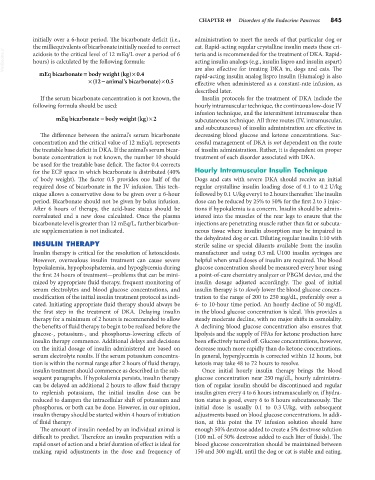Page 873 - Small Animal Internal Medicine, 6th Edition
P. 873
CHAPTER 49 Disorders of the Endocrine Pancreas 845
initially over a 6-hour period. The bicarbonate deficit (i.e., administration to meet the needs of that particular dog or
the milliequivalents of bicarbonate initially needed to correct cat. Rapid-acting regular crystalline insulin meets these cri-
VetBooks.ir acidosis to the critical level of 12 mEq/L over a period of 6 teria and is recommended for the treatment of DKA. Rapid-
acting insulin analogs (e.g., insulin lispro and insulin aspart)
hours) is calculated by the following formula:
=
mEq bicarbonatebody weight kg × .04 are also effective for treating DKA in, dogs and cats. The
)
(
rapid-acting insulin analog lispro insulin (Humalog) is also
.
× (12 − animal’s bicarbonatte)× 05 effective when administered as a constant-rate infusion, as
described later.
If the serum bicarbonate concentration is not known, the Insulin protocols for the treatment of DKA include the
following formula should be used: hourly intramuscular technique, the continuous low-dose IV
infusion technique, and the intermittent intramuscular then
=
mEq bicarbonatebody weight kg × 2 subcutaneous technique. All three routes (IV, intramuscular,
(
)
and subcutaneous) of insulin administration are effective in
The difference between the animal’s serum bicarbonate decreasing blood glucose and ketone concentrations. Suc-
concentration and the critical value of 12 mEq/L represents cessful management of DKA is not dependent on the route
the treatable base deficit in DKA. If the animal’s serum bicar- of insulin administration. Rather, it is dependent on proper
bonate concentration is not known, the number 10 should treatment of each disorder associated with DKA.
be used for the treatable base deficit. The factor 0.4 corrects
for the ECF space in which bicarbonate is distributed (40% Hourly Intramuscular Insulin Technique
of body weight). The factor 0.5 provides one half of the Dogs and cats with severe DKA should receive an initial
required dose of bicarbonate in the IV infusion. This tech- regular crystalline insulin loading dose of 0.1 to 0.2 U/kg
nique allows a conservative dose to be given over a 6-hour followed by 0.1 U/kg every1 to 2 hours thereafter. The insulin
period. Bicarbonate should not be given by bolus infusion. dose can be reduced by 25% to 50% for the first 2 to 3 injec-
After 6 hours of therapy, the acid-base status should be tions if hypokalemia is a concern. Insulin should be admin-
reevaluated and a new dose calculated. Once the plasma istered into the muscles of the rear legs to ensure that the
bicarbonate level is greater than 12 mEq/L, further bicarbon- injections are penetrating muscle rather than fat or subcuta-
ate supplementation is not indicated. neous tissue where insulin absorption may be impaired in
the dehydrated dog or cat. Diluting regular insulin 1:10 with
INSULIN THERAPY sterile saline or special diluents available from the insulin
Insulin therapy is critical for the resolution of ketoacidosis. manufacturer and using 0.3 mL U100 insulin syringes are
However, overzealous insulin treatment can cause severe helpful when small doses of insulin are required. The blood
hypokalemia, hypophosphatemia, and hypoglycemia during glucose concentration should be measured every hour using
the first 24 hours of treatment—problems that can be mini- a point-of-care chemistry analyzer or PBGM device, and the
mized by appropriate fluid therapy, frequent monitoring of insulin dosage adjusted accordingly. The goal of initial
serum electrolytes and blood glucose concentrations, and insulin therapy is to slowly lower the blood glucose concen-
modification of the initial insulin treatment protocol as indi- tration to the range of 200 to 250 mg/dL, preferably over a
cated. Initiating appropriate fluid therapy should always be 6- to 10-hour time period. An hourly decline of 50 mg/dL
the first step in the treatment of DKA. Delaying insulin in the blood glucose concentration is ideal. This provides a
therapy for a minimum of 2 hours is recommended to allow steady moderate decline, with no major shifts in osmolality.
the benefits of fluid therapy to begin to be realized before the A declining blood glucose concentration also ensures that
glucose-, potassium-, and phosphorus-lowering effects of lipolysis and the supply of FFAs for ketone production have
insulin therapy commence. Additional delays and decisions been effectively turned off. Glucose concentrations, however,
on the initial dosage of insulin administered are based on decrease much more rapidly than do ketone concentrations.
serum electrolyte results. If the serum potassium concentra- In general, hyperglycemia is corrected within 12 hours, but
tion is within the normal range after 2 hours of fluid therapy, ketosis may take 48 to 72 hours to resolve.
insulin treatment should commence as described in the sub- Once initial hourly insulin therapy brings the blood
sequent paragraphs. If hypokalemia persists, insulin therapy glucose concentration near 250 mg/dL, hourly administra-
can be delayed an additional 2 hours to allow fluid therapy tion of regular insulin should be discontinued and regular
to replenish potassium, the initial insulin dose can be insulin given every 4 to 6 hours intramuscularly or, if hydra-
reduced to dampen the intracellular shift of potassium and tion status is good, every 6 to 8 hours subcutaneously. The
phosphorus, or both can be done. However, in our opinion, initial dose is usually 0.1 to 0.3 U/kg, with subsequent
insulin therapy should be started within 4 hours of initiation adjustments based on blood glucose concentrations. In addi-
of fluid therapy. tion, at this point the IV infusion solution should have
The amount of insulin needed by an individual animal is enough 50% dextrose added to create a 5% dextrose solution
difficult to predict. Therefore an insulin preparation with a (100 mL of 50% dextrose added to each liter of fluids). The
rapid onset of action and a brief duration of effect is ideal for blood glucose concentration should be maintained between
making rapid adjustments in the dose and frequency of 150 and 300 mg/dL until the dog or cat is stable and eating.

